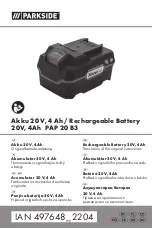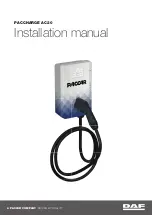
8
11
15.GB
2
Description of the operating controls and indicating elements
1
3
5
6
7
4
2
Item
Operating control /
indicating element
Function
1
“Standby” LED (green)
t
lights up when the battery charger is ready for operation
2
“Charging” LED
(yellow)
t
indicates the charging process
3
Control key
t
The control key has the following functions:
- Stop / Continue charging (break function)
- Manual equilising charge
- Charging state indicator
4
LED
”Compensation
charge”
t
indicates the equilising charge
5
LED
“Warning messages”
(yellow)
t
Indicates faults that affect charging, via a flashing code.
Flashing pulses
:
Meaning:
2
Incorrect battery voltage
3
Safety charge exceeded
(Main charging time or recharging time in case of
pulse charging)
4
Excess temperature
5
Mains failure (is only indicated when the charging
state indicator is queried)
6
Warning requested by the optional board.
The exact error is indicated on the optional board.
6
LED
“Service messages”
(red)
t
Indicates problems, via a flashing code, that can only be rectified by
repair work
Flashing pulses
:
Meaning:
2
Charging switch or current measurement defective
3
Voltage coding/setting incorrect
4
Service message requested by the options board.
The exact error is indicated on the optional board.
7
“Charging completed”
LED (green)
t
Charging complete, battery is fully charged.
t
= Standard equipment
o
= Optional equipment
9
11
15.GB
3
Commissioning the battery charger
3.1
Connecting the charger
M
When connecting the charger, make sure
the contact of the charging cable is secure.
A poor contact, for instance at the charging
connection, can result in constant charging
current fluctuations which will affect the
charging electronics and show an incorrect
charging current display.
3.2
Starting the charging operation
When the mains plug is connected, the
green “Standby” LED (1) lights up.
The battery charger automatically switches
on when the charger and the battery are
connected. The first yellow LED (2) on the
charge display lights up.
Z
Charging is delayed by approx. 5 to
7 seconds in order to prevent charging
connector sparking.
Charging will not start, as long as the
battery voltage is outside the expected
range.
3.3
Battery charging sequence
Charging is indicated by the ascending
yellow “Charge” LED's (2) on the charge
indicator.
When the battery is fully charged, the green
“Charging completed” LED (7) lights up.
The battery charger automatically stops
charging.
Trickle charging:
When the battery remains connected, every
8 hours, following the completion of the
charging operation, a trickle charge is
initiated lasting for 8 minutes. The yellow
LEDs (2) light up. The green LED (7) for
“Charging complete” goes off during the
trickle charge phase.
Z
The battery charger automatically
terminates charging when the charging
time has elapsed. This process is repeated
for as long as the battery is connected to
the charger.
3.4
Mains supply
Mains failure:
If the battery is connected, a mains failure
will stop the time basis of the charging
switch and store the position of the
charging program.
All LED displays go out. When the mains
supply is restored the LEDs display the
previous condition. The battery charge
continues. The stored charging indication,
however, will be lost, when a mains failure
occurs without a battery being connected.
Low voltage:
Dropping below the admissible charging
current, for instance as a result of low
mains voltage, requires longer charging
periods or can result in insufficient charging
(warning message).
3.5
Fault indication (safety cut-out)
Gassing voltage:
If the battery does not reach the gassing
voltage within 12 hours, the safety system
interrupts the charging operation.
The yellow warning LED (5) flashes (3x /
interval / 3x). Disconnect the battery from
the battery charger and check it.
Battery voltage:
In the event of battery overvoltage or
undervoltage, the charge switch will not
start up charging. The yellow warning
LED (5) flashes (2x / interval / 2x). Observe
a short pause, until the battery voltage is
within the expected range. Check the
voltage class of the battery, if necessary.
Transformer overheating:
A sensor interrupts charging in the event of
excessive transformer temperature.
The yellow warning LED (5) flashes (4x /
interval / 4x). When the transformer cools
down to the permissible temperature, the
error indication goes off and charging is
continued.
Charging switch error:
The red “Service message” LED
(6)
flashes. Disconnect the battery from the
mains, then restart the charging operation.
Check the battery assignment and adjust if
necessary. Otherwise notify the
manufacturer’s authorised customer
service department and withdraw the
charger from use.
Z
The operating state “Charging
completed” (7) can only be cancelled, when
the battery connector is removed from the
charging socket. This will prevent
unintentional double chargings.
Содержание SLT 100
Страница 1: ...SLT 100 SLT 100 Operating instructions 50451882 SLT 100 G 10 04 11 15...
Страница 4: ...I2 0709 GB...
Страница 23: ......
Страница 24: ......










































